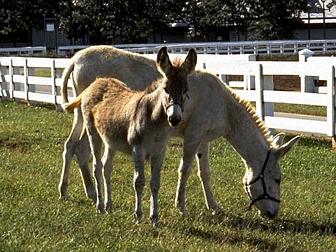
OVERVIEW
The Donkey (or domesticated ass) is known and used throughout the world for its ability to carry heavy loads over the most demanding terrain. On the other hand, it is also noted for its occasional refusal to budge so much as an inch whether carrying a load or not. The Donkey is an ancient form of equid found in varying local types. It was first domesticated 5,000 years ago, some time before the domestication of the horse. A Jack (male ass) crossed with a female horse produces a mule, which is also a strong and useful animal. Donkeys are put to various uses, from carrying burdens in remote areas to performing in elegant harness in shows.
PHYSICAL DESCRIPTION
Donkeys are really domesticated wild asses. There are two types, the African and the Asiatic. The African wild ass is considered the original ass. It is called the Nubian due to its place of origin, the Nubian desert. It stands 12 hands high. It has a black stripe on the shoulder and is usually gray with a white belly, large ears and narrow hooves. The Asiatic Wild Ass included the Onagers of Western Asia, and the Kiangs and Kulans of Central Asia. Asiatic asses roam in great herds in remote areas. The Kiang stands up to 14 hands and is brown with a light belly. The Kulan stands only 12.2 hands and is reddish-yellow color with dun lower parts.
ORIGIN
It is asserted by some that the ass originally was found throughout the deserts of northern Africa. After it was domesticated, the ass was brought to Asia by traders, where some believe it gave rise to the Asiatic Wild Ass. The Donkey, which appears in great numbers throughout the world, is the domesticated version of the Nubian Ass.
INTERESTING FACTS
George Washington had some of the most famous donkeys in American history. Washington wished to develop a fine mule for agricultural use. In 1785, he received three asses - a Jack and two Jennies - as a gift from the Spanish king. The Jack was named Royal Gift, and stood at Mt. Vernon and other locations in Virginia. The Marquis de Lafayette sent Washington a Maltese Jack named the Knight of Malta, which was described as having "the fire and ferocity of a tiger," but he was an excellent sire of mules. A quality Jack at this time demanded a large sum of money. Royal Gift got a fee of 15 pounds in 1786. A few years earlier, the imported Thoroughbred sire, Messenger, was getting only 5 pounds.
INFLUENCES
1. Eohippus
2. Mesohippus
3. Miohippus
4. Merychippus
5. Pliohippus
6. Asinus
For more information:
The American Donkey and Mule Society, Inc.